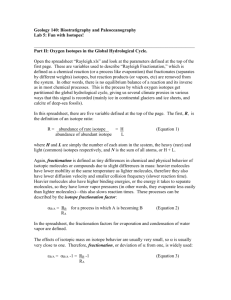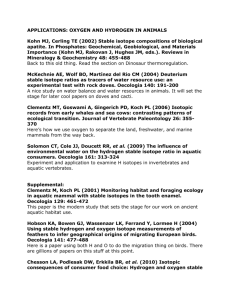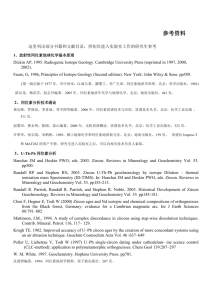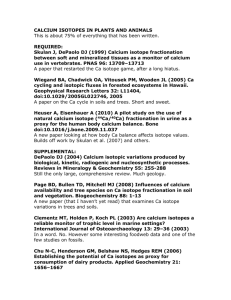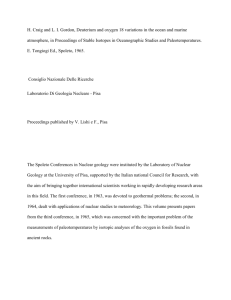Aquatic Photosynthesis
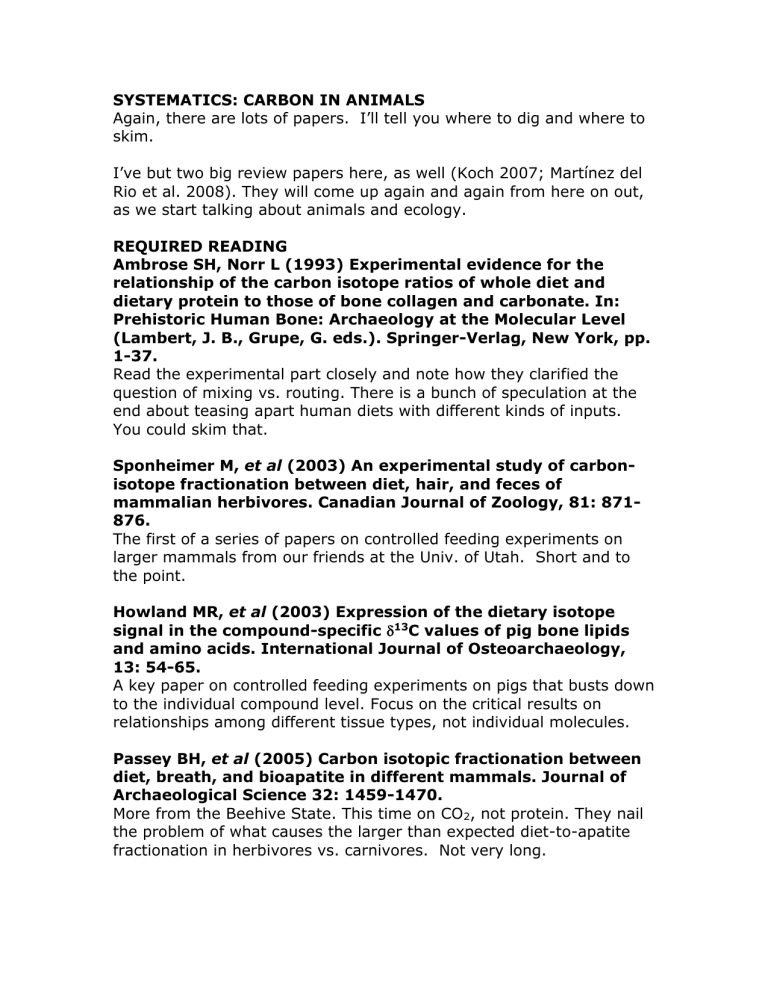
SYSTEMATICS: CARBON IN ANIMALS
Again, there are lots of papers. I’ll tell you where to dig and where to skim.
I’ve but two big review papers here, as well (Koch 2007; Martínez del
Rio et al. 2008). They will come up again and again from here on out, as we start talking about animals and ecology.
REQUIRED READING
Ambrose SH, Norr L (1993) Experimental evidence for the relationship of the carbon isotope ratios of whole diet and dietary protein to those of bone collagen and carbonate. In:
Prehistoric Human Bone: Archaeology at the Molecular Level
(Lambert, J. B., Grupe, G. eds.). Springer-Verlag, New York, pp.
1-37.
Read the experimental part closely and note how they clarified the question of mixing vs. routing. There is a bunch of speculation at the end about teasing apart human diets with different kinds of inputs.
You could skim that.
Sponheimer M, et al (2003) An experimental study of carbonisotope fractionation between diet, hair, and feces of mammalian herbivores. Canadian Journal of Zoology, 81: 871-
876.
The first of a series of papers on controlled feeding experiments on larger mammals from our friends at the Univ. of Utah. Short and to the point.
Howland MR, et al (2003) Expression of the dietary isotope signal in the compound-specific 13 C values of pig bone lipids and amino acids. International Journal of Osteoarchaeology,
13: 54-65.
A key paper on controlled feeding experiments on pigs that busts down to the individual compound level. Focus on the critical results on relationships among different tissue types, not individual molecules.
Passey BH, et al (2005) Carbon isotopic fractionation between diet, breath, and bioapatite in different mammals. Journal of
Archaeological Science 32: 1459-1470.
More from the Beehive State. This time on CO
2
, not protein. They nail the problem of what causes the larger than expected diet-to-apatite fractionation in herbivores vs. carnivores. Not very long.
Big reviews
Koch PL (2007) Isotopic study of the biology of modern and fossil vertebrates. In: Michener R, Lajtha K (eds) Stable
Isotopes in Ecology and Environmental Science, 2 nd Edition.
Blackwell Publishing, Boston, pp 99-154
An overly long, overly tedious chapter on everything isotopic in vertebrates. Pages 99-105 cover simple background on vertebrate tissues, then pages 105-109 dive into the controls on carbon isotope variations.
Martínez del Rio C, Wolf N, Carleton SA, Gannes LZ (2009)
Isotopic ecology ten years after a call for more laboratory experiments. Biological Reviews 84: 91–111
If you are up for, read the whole thing now. If not, focus on the carbon parts, specifically the following sections: IV, V 1-2, 4. More from this paper later in the course.
Further Reading
Kelly JF (2000) Stable isotopes of carbon and nitrogen in the study of avian and mammalian trophic ecology. Canadian
Journal of Zoology 78: 1-27.
The most recent whopping big review of trophic fractionations and other patterns in animal C and N isotopes.
Fox-Dobbs K, Bump JK, Peterson RO, Fox DL, Koch PL (2007)
Carnivore-specific stable isotope variations and variation in foraging ecology of modern and ancient wolf populations: case studies from Isle Royale, Minnesota, and La Brea. Canadian
Journal of Zoology 85: 458-471
Not controlled feeding, but as close as we are likely to get for a large carnivore on a natural diet.
Pearson SF, Levey DJ, Greenberg CH, del Rio CM (2003) Effects of elemental composition on the incorporation of dietary nitrogen and carbon isotopic signatures in an omnivorous songbird. Oecologia, 135: 516-523.
A nice short feeding study, and one of the few that examines omnivores. We will read it when we get to N in animals.
Jim S, Ambrose SH, Evershed RP (2004) Stable carbon isotopic evidence for differences in the dietary origin of bone cholesterol, collagen and apatite: Implications for their use in palaeodietary reconstruction. Geochimica et Cosmochimica
Acta, 68: 61-72.
A study very similar to Howland et al. (03), but this time on the rats that Ambrose and Norr studied.
Trueman CN, McGill RAR, Guyard PH (2005) The effect of growth rate on tissue-diet isotopic spacing in rapidly growing animals. An experimental study with Atlantic salmon (Salmo salar). Rapid Communications in Mass
Spectrometry 19: 3239-3247.
Here is one for the lovers of salmonids (and other teleosts). This is one of several studies documenting that growth rate affects the diet-totissue isotope spacing (may be what is going on in Pearson et al.
2003). We will spend a day on turnover and growth rate later in the class, but this lays out the basic fractionation factors for fish.




